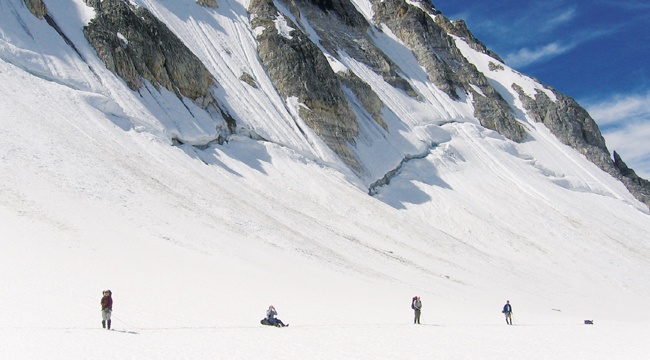Take it Outside
Using the outdoors as a classroom capitalizes on children’s natural curiosity and enthusiasm — plus, they earn the freedom to roam
by Barb Livingstone
His bio reads as the ultimate definition of a mountain man: Heli-ski guide; ascents in Europe, the Americas and Asia, including Mt. Everest; author of the world’s first waterfall ice-climbing guidebook; and, for the past 17 years, program co-ordinator, instructor and guide of avalanche safety and mountain programs at the University of Calgary Outdoor Centre.
This fall, Albi Sole, MKin’08, will begin a new life chapter. As the first full-time executive director of the Outdoor Council of Canada (outdoorcouncil.ca) — a 600-member national organization formed in 2008 with UCalgary’s support — the 61-year-old will inspire more Canadians to get outside, while standardizing credentials for outdoor leaders.
Sole says the benefits of physical activity in prolonging life — especially in an era when Statistics Canada reports an estimated 31 per cent of children aged five to 17 are overweight or obese — have been well-proven.
Research for decades has touted the benefits of outdoor activities, from the obvious physical advantages of getting off the couch, to stress relief, increased energy and less depression and anger.
The Outdoor Council, with funding from private and corporate donations and its courses, wants to turn around an increasingly sedentary Canadian culture and combat its fear of the outdoors.
“People are afraid of bears, of avalanches, of getting cold or wet,” says Sole, who currently serves as part-time head poobah at OCC. “They do not have a strong belief around their ability to cope in the outdoors.”
Much of the council’s work involves certifying outdoor leaders, particularly in schools and organizations that work with kids. More than 1,000 people have already taken the course and the number doubles every year.
“Particularly encouraging is that post-secondary institutions are starting to include the course in pre-service training for teachers,” says Sole, who, as a young man, dropped out of university in England and worked as a stevedore, a roughneck and on an exploration rig as a derrickman, before discovering Canada’s wilderness. He predicts in five years OCC will have trained at least 10,000 leaders; in 10 years, 40,000.
Grade 3 teacher Ryan Lemphers of Okotoks’ École Percy Pegler School has taken OCC’s courses and last year helped certify 40 outdoor leaders, almost all schoolteachers.
Before teaching, Lemphers ran adventure camp programs. Last year, he started an extracurricular outdoor club for Grade 5 and 6 students.
Twenty-one kids joined that first year; this year, 40 signed up.
When the kids head outdoors, they explore questions like how to be responsible in nature (map study and compass work) or be a friend (how safety means everyone supporting each other).
Besides curriculum links and physical benefits, Lemphers cites powerful psychological effects.
The council expands on the work and ethos created by UCalgary’s Outdoor Centre. The largest university facility of its kind in North America, it sees 15,000 course participants (in everything from hang-gliding and climbing — ice, walls and rocks — to canoeing and wilderness first-aid) each year.
This summer will be retired engineer Ken Sourisseau’s third time that he has spent tracing the historic canoe trip of the fur traders into Hudson Bay.
The 61-year-old signed up in 2013 for an extended Outdoor Centre guided trip along Saskatchewan’s Churchill River. Nudging retirement meant, “I had extra time on my hands,” he says, adding his youngest child’s canoe camp, “was a life-altering event for her. She inspired me with her enthusiasm.” Last year, Souriseeau’s wife joined the adventure.
“Where we went, you were disconnected from everything,” says Souriseeau. “We put in at one point where the road met the water and it was two weeks before you saw the road again. I even left my watch at home. No cellphone, e-mail, computer; just rocks, trees and water, and people talking with each other and working as a team.”
For Sole, who based his masters thesis in kinesiology on a health sciences approach to avalanche risk, the outdoor advantages are obvious.
“We glorify super-athletes, but hurt, pain, sweat is not for everyone. And gyms are expensive,” says Sole, a former Boy Scout. “Instead, just get outside. Take a walk and have a conversation with your wife or a friend. If you ask outdoors people why they do it, physical activity is way down the list. They are very fit people, but they do it because it relieves stress, it’s social and they love nature.
“Fitness is the result, not the reason.” U












 An Outdoor Centre glacier hike – just below the north face of Quadra near Lake Louise, Banff National Park
An Outdoor Centre glacier hike – just below the north face of Quadra near Lake Louise, Banff National Park